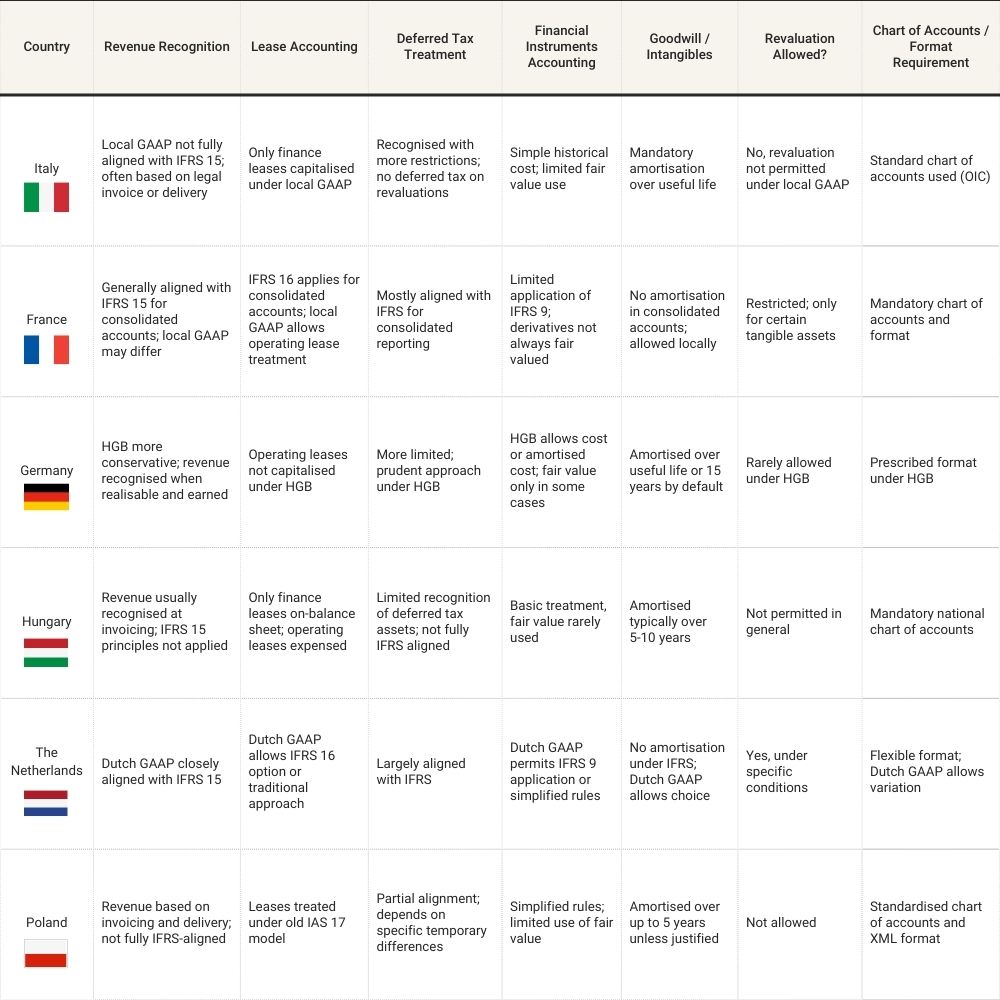Assessing financial reporting differences across Europe

While local GAAP is typically influenced by IFRS, there are significant differences that will shape accounting and tax treatment.
This short guide explores the challenges associated with achieving consistent financial reporting across Europe, highlighting the pain points businesses are facing that can hinder finance transformation efforts – and how to overcome them.
The European Union’s (EU’s) alignment to International Financial Reporting Standards (IFRS) for accounting purposes seeks to streamline financial reporting.
In most European countries, public entities are subject to IFRS and must prepare their accounts accordingly. Private entities usually need to follow the local Generally Accepted Accounting Principles (GAAP), which are often influenced by IFRS.
However, differences do exist. This is largely due to the fact that IFRS as adopted by the EU sometimes lags behind actual IFRS standards. The EU regularly goes through an endorsement process, which results in a gap of approximately six months between the implementation of a new standard and implementation in practice.
When it comes to private entities and local GAAP, key differences tend to occur in the European countries where standards aren’t aligned to IFRS. In Italy, for example, goodwill must be amortised, revaluation isn’t allowed, there are specific capitalisation rules and only operating leases are recognised.
Consider the format of your accounting reports carefully
Such differences are therefore derived not so much from the accounting principles themselves but from the format of accounting reports, and how you need to prepare the accounting information in order to comply with local rules.
To further illustrate this point, in France and Romania, there are very specific regulations around chart of accounts, format of the trial balance, general ledger and accounting reporting.
It’s advisable to work with a local provider when operating in these jurisdictions.
The right partner can help you navigate the report particulars, as wind power solutions leader Suzlon found out when it teamed up with TMF Group to establish operations in Romania.
Remember that different countries equal different tax rules
When it comes to financial reporting, many differences sit on the tax side rather than the accounting side. This becomes evident when you examine the varied rankings of European jurisdictions in the Global Business Complexity Index.
You need to follow local tax rules in order to file your returns and make tax payments in-country, and there is a variance between IFRS / local GAAP and what you will need to calculate and reflect for tax purposes.
Deferred tax is a common example. IFRS requires recognition of temporary differences but many local GAAPs apply more restrictive criteria, such as disallowing deferred tax assets unless future taxable profits are virtually assured. These differences can distort the effective tax rate, and data quality, and require careful reconciliation during group reporting.
It’s not surprising to see such differences across the European tax landscape when you consider the purpose is very narrow – to provide information to the governmental authority and pay taxes on your local profits and activities. Tax isn’t regulated by an international body, as in the case of IFRS, and tax regulation therefore varies depending on individual country policies and government targets.
Keep track of the increasing efforts at alignment – but be aware differences will persist
There are now several ongoing initiatives in Europe aimed at harmonising tax and financial reporting frameworks across EU member states.
The EU VAT Directive, also known as the EU VAT Code, serves as the foundation for VAT regulations within the bloc. It ultimately aims to harmonise VAT systems among member states and establish a range for VAT rates, allowing for a more streamlined and efficient taxation process.
Another major development to watch closely is the proposal for a Common Consolidated Corporate Tax Base, recently rebranded under the BEFIT (Business in Europe: Framework for Income Taxation) initiative. This would allow multinational groups operating in multiple EU countries to calculate their taxable base in a more unified manner, allocating profits among member states based on a prescribed formula.
While such initiatives aim to reduce compliance complexity, national differences remain. Tax systems will continue to reflect domestic economic priorities and implementation of EU-level initiatives can be slow and politically sensitive.
Full alignment therefore remains a challenge and material differences exist between IFRS and local GAAP across Europe. The table below summarises key accounting treatments and how they differ in selected markets:

TMF Group’s EU country profiles contain additional country-specific insights and highlight the risks of non-compliance with local legislation.
Your financial reporting checklist
There are several important aspects to consider when it comes to financial reporting and keeping on top of accounting standards in different jurisdictions.
- The format of the financial report and country-specific requirements, which can vary significantly in complexity
- Differences in terms of accounting treatment in areas such as foreign exchange rates, fixed assets, how depreciation is calculated and inventory valuation
- The need to adapt your financial systems to meet local statutory requirements, including chart of accounts structure, SAF-T/XML reporting and local language outputs. Without this, even technically correct accounting may still fail local compliance checks
When you expand operations into a new country, you should carefully check both the format of financial reports and also the substance, because this is where local rules may be different to IFRS. You need to then consider how you are going to incorporate those local rules into your general financial reporting system whilst avoiding the challenge of maintaining multiple, disparate platforms for accounting and tax.
Understanding the impact on your bottom line
Knowing – and understanding – the differences in financial reporting and accounting standards in Europe is essential to properly establishing your operations and appreciating the true cost of doing business in your chosen location.
Companies are often required to maintain dual reporting frameworks, preparing local statutory accounts under local GAAP for legal and tax compliance, while also producing group consolidated financials under IFRS or US GAAP. This adds complexity to month-end close, increases audit effort and time spent on local compliance coordination, and may necessitate parallel ledgers or reconciliation tools within your ERP system.
Working with a third-party provider in-country provides an optimal solution, giving you access to local experts with the knowledge, technology and language skills to help you stay on top of evolving accounting and tax rules.
Keeping a close eye on Europe’s accounting standards
Having the right professionals in place who can technically assess the latest changes, and explain how they impact your business, is invaluable.
Find out how TMF Group’s international team of accounting and tax experts can simplify your financial reporting across borders.
Key takeaways
- Expect format and filing differences by country
- IFRS adoption may lag or differ from EU-endorsed versions
- Tax rules are country-specific and rarely aligned with accounting
- Deferred tax and local rules may require dual reporting
- Local subject matter experts and tools are essential for conquering compliance




